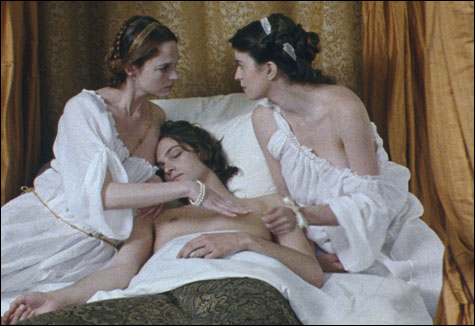
PICTURE PERFECT? Rohmer, like Godard, finishes his career painting with light. |
| Romance of Astrea and Celadon | Directed by Eric Rohmer | Written by Eric Rohmer based on the Novel by Honoré D’urfé | with Andy Gillet, Stéphanie Crayencour, Cécile Cassel, Véronique Reymond, and Rosette | Koch Lober Films | French | 109 minutes | Museum of Fine Arts: September 5, 7, 10, 12, 12, 17, 18 |
Now 88 years old, Eric Rohmer, a leading light of the French New Wave and a former film critic at Cahiers du cinéma, says Romance ofAstrea and Celadon [Les amours d’Astrée et de Céladon] is his last film. That people who have never seen a Rohmer film might not want to start with this one is a fair warning. Based on a 17th-century novel by Honoré d’Urfé and set in fifth-century-BC Gaul, Astrea and Celadon features a cast of French Renaissance Faire hippie-dippies playing shepherds and shepherdesses, nymphs and druids. It may be a Rohmerian moral tale, but it is far removed from the Parisian world of contemporary amour that Rohmer has been investigating over the past 40 years or so.On the other hand, if you’re in the position to make Rohmer’s last movie the first one you see, do it. That way, when you get around to seeing classic Rohmer films like My Night at Maud’s, Claire’s Knee, A Summer’s Tale, or A Winter’s Tale, they will seem very strange, possibly even stranger than Astrea and Celadon. They won’t seem like talky relationship films at all. Under the influence of Astrea and Celadon, you will see them in the context Rohmer intended. They will appear to you as quasi-mystical love stories in which lovers, with a flat intensity, play for high stakes amid a deceptive, fragile calm. Or maybe that’s not your cup of tea either.

They say when a director dies, he becomes a photographer. But what if before he dies he becomes a painter? Astrea and Celadon presents viewers with a number of paintings on classical themes. At the same time, it demonstrates how the cinema transcends painting, furthers its work. The cinematography and the camerawork in this film equal any in Rohmer’s œuvre. We see characters outdoors, from a distance or in Rohmerian medium shots, not large in the frame but not dwarfed by nature. It’s a human perspective we’re not used to anymore.
“I’m alive!” Those are practically the last words of this death-haunted but sun-dappled film by an old man. Astrea and Celadon calls to mind the “Miracle” section of Roberto Rossellini’s L’amore, but without that film’s wink. In fact, this may be the least cynical film ever made, not to mention the most unhip. Here, Rohmer has put a foundation under airy-fairy French castles, and if at times, particularly during a montage of dissolves of lovers’ faces in nature, Astrea and Celadon resembles a feminine-hygiene ad from the 1970s, so what?
The film is totally the product of a lifetime’s worth of artistic reflection; all Rohmer’s æsthetic pursuits come together in an open and unconcerned way. In one scene by a river, we seem to be witnessing the last scene of unspoiled nature that will ever be shot. The film’s fey quality extends to its somewhat creepy and awkward obsession with cross-dressing, and some of it is frankly unbelievable. Yet it’s a valedictory to much of what the French New Wave set out to do, in both writing and filmmaking. To paraphrase a line of dialogue from it, it spares us the pain of averting our gaze.
Romance of Astrea and Celadon represents a last gasp of more than the New Wave. Imbued with a commune-centric feel for certain pastoral longings of late-1960s culture, it’s also a last gasp of ’60s-style nudist-colony Christianity. It attempts to redeem the disrupted pastoral sections of Godard’s Weekend, and with its nature settings, it has the offhand quality of “bad” Godard from the late 1960s, like Wind from the East. Its use of paintings also calls to mind Godard’s Passion, though it’s nothing like that film. Fifty years after they first met and worked together, both Rohmer and Godard finish their careers as painters in light.